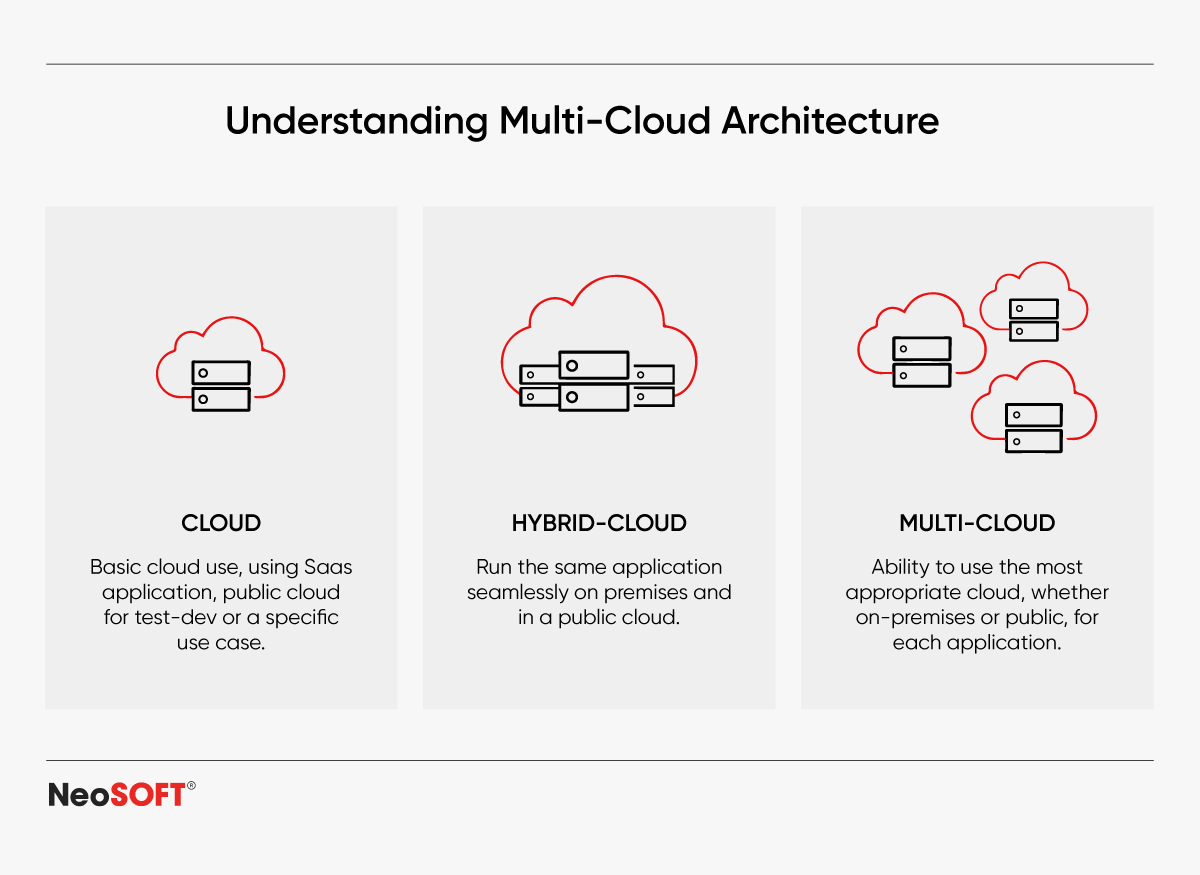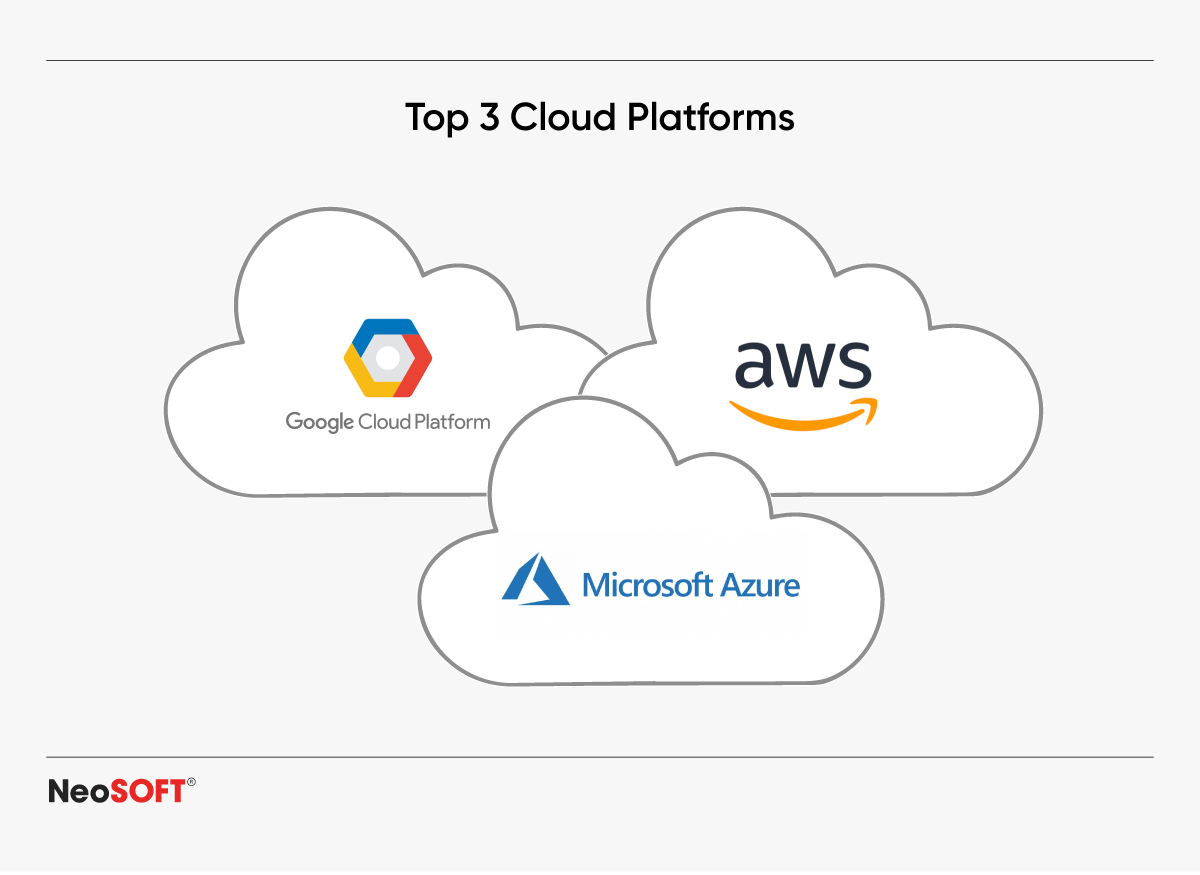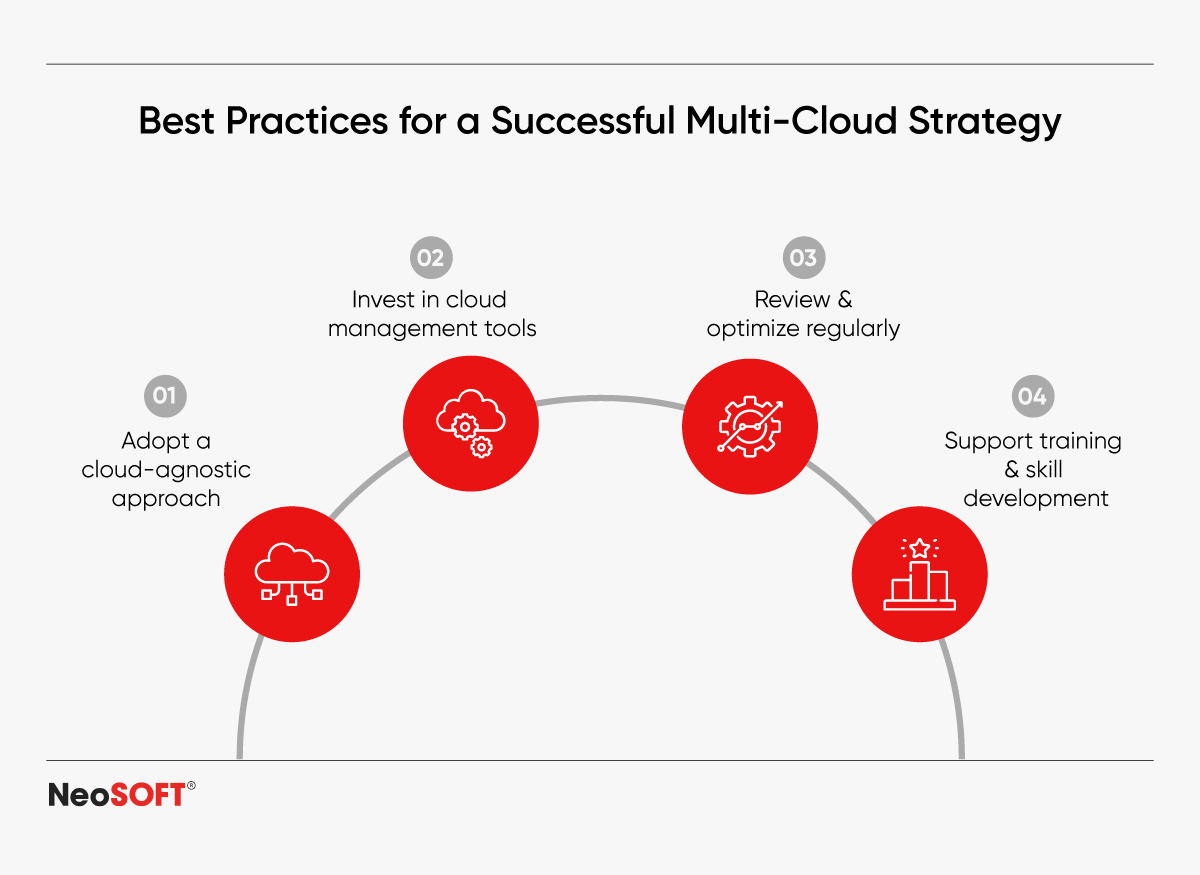Key Considerations for Developing a Multi-Cloud Strategy
September 12, 2024
Introduction
In the past few years, the explosive development in technology has revolutionized the business landscape across industries and sectors, bringing better cloud computing services, increased analytics, and flexible software solutions. This has sparked considerable excitement about multi-cloud computing, which improves agility and adaptability to suit the needs of modern enterprises across a variety of cloud settings.
In 2022, Oracle carried out a survey which brought to light the increasing demand for cloud services, especially multi-cloud computing. 98% of the global organizations surveyed in this study either use multi-cloud systems currently or plan to do so in the near future.
The study also reported that 96% of the organizations polled are using various different cloud providers. The COVID-19 pandemic has also sped up this adoption, with businesses looking to boost growth and innovation across multiple cloud environments by delivering seamless multi-cloud infrastructure. Multi-cloud strategies are becoming more and more important in cost reduction, innovation, and international service delivery as businesses grow.
This blog provides an in-depth account of multi-cloud strategies and explores why they have become so essential for contemporary software and IT infrastructures. Targeting IT specialists, decision-makers, and company executives who wish to enhance their cloud infrastructure, boost adaptability, and reduce vendor lock-in, the blog also covers emerging trends and best practices to help businesses stay on top of the rapidly evolving cloud market.
Defining Multi-Cloud Strategy
The utilization of several cloud providers within a single architecture is known as a multi-cloud strategy. Instead of being limited to a single cloud provider, businesses may distribute their workloads over several platforms. By using this approach, they can leverage the features offered by several providers, customizing the cloud environment to suit their specific requirements and optimize efficiency.
Businesses can seek greater resilience, agility, and creativity while responding to evolving market conditions and technological breakthroughs with the flexibility provided by a multi-cloud strategy. By keeping away with any risk of vendor lock-in, businesses can choose from a wide range of cloud solution providers’ best offerings and features, without becoming unduly dependent on any one provider. In today’s technologically evolved environment, having a multi-cloud approach is crucial.
Why Choose a Multi-Cloud Solution?
Opting for a multi-cloud strategy has major benefits, some of which are:
Avoid vendor lock-in: By diversifying their cloud vendors, businesses can lower the risks involved with working with only one cloud provider. This flexibility enables switching cloud providers if better alternatives become available or if their present supplier suffers problems.
Improve recovery: Data and apps are dispersed over numerous platforms in a multi-cloud system, providing inbuilt redundancy. This decreases the risk of downtime and loss of data while also ensuring business continuity in the event of a breakdown in one cloud service.
Enhance performance: Cloud computing companies are thriving in numerous domains, including computational power, storage, and application services. Businesses that use various providers can improve performance for specific workloads, assuring the best possible results.
Types of Multi-Cloud Deployments
Apps and data are shared between public and private clouds in a hybrid cloud architecture. The strategy of storing sensitive workloads in private clouds and utilizing the scalability of public clouds for different purposes provides significant flexibility.
Multi-cloud, on the other hand, employs various public clouds from various different public cloud providers, such as AWS, Microsoft Azure, and Google Cloud, without necessarily integrating with private cloud services. This enables organizations to select the best products and services from a variety of providers, reducing single-vendor reliance while boosting performance and lowering costs and redundancy.
When contemplating adopting cloud systems, it is critical to understand the key differences between multi-cloud and hybrid cloud deployments in order to determine which configuration will be most effective for the needs of your project.
Key Components of Multi-Cloud Architecture
A strong multi-cloud architecture relies on several fundamental components:
Cloud platforms – These are the core infrastructure, services, and tools offered by public cloud providers such as Amazon Web Services, Google Cloud, and Microsoft Azure. They consist of computation, storage, and networking capabilities, which are the foundation of a multi-cloud solution.
Networking – It is important to ensure seamless connectivity between various cloud platforms. This involves integrating networks from several providers, ensuring that data transfers and communication across cloud services are efficient and safe.
Security and compliance – With data spread across several clouds, security is paramount. This includes deploying identity management, encryption, and compliance monitoring across every platform.
Management tools – To manage numerous clouds effectively, tools that provide visibility, automation, and resource control across multiple clouds are required. These solutions help with performance monitoring, cost management, and compliance across several cloud environments.
Key Considerations for Implementing Multi-Cloud Strategies
Evaluating Business Goals
Before beginning your multi-cloud journey, make sure the chosen approach is aligned with your organization’s overall business goals. Establishing your goals for adopting a multi-cloud solution, such as cost savings, increased flexibility, improved disaster recovery, or availability of specialist cloud-native services, is the first step. Choosing which cloud service providers and providers to use can be made easier if you are cognizant of these aims.
Additionally, it’s important to assess your performance goals and workload. Not every task is the same; some may require a large amount of processing power, while others may call for a large amount of storage or certain security measures. You can determine which cloud services are most appropriate for each need by evaluating your workloads. This will ensure that your multi-cloud setup operates at peak performance and efficiency, taking advantage of many cloud services with this customized approach.
Security and Compliance
Protecting data across several cloud environments demands robust safety processes. Apply encryption, access limits, and constant monitoring to protect data in transit as well as at rest. Make sure that all your cloud service providers follow your security standards and function effectively with your complete security strategy.
Compliance with rules and data sovereignty legislation is essential. Recognize the laws governing the data processing and storage in each jurisdiction that your cloud providers do business. Review and update your rules on data sovereignty on a regular basis to ensure that your cloud strategy is in line with industry regulations and handles any sensitive data and residency concerns.
Cost Optimization
To efficiently manage costs in a multi-cloud scenario, leverage the strengths and prices of each cloud provider. To save money, use cost-effective services for certain workloads and reserved instances, spot instances, or bulk discounts. Regularly assess your cloud usage to prevent waste and ensure that you only pay for what you need.
Use cloud cost management technologies to track and optimize expenditure across multiple cloud providers. Tools like AWS Cost Explorer, Azure Cost Management, and third-party solutions give you insight into expenses, allowing you to analyze consumption, build budgets, and receive alerts for possible overspending. These tools help in keeping costs on track with your financial objectives.
Interoperability and Integration
An effective multi-cloud strategy calls for seamless interaction between different cloud platforms. This includes creating consistent APIs, utilizing cloud-agnostic technologies, and making sure your apps and services interact effectively across many different environments. Prioritizing integration right from the outset will decrease complexity and improve operations.
Transferring information across multiple cloud providers helps but can be challenging in terms of bandwidth, latency, and security. To address these difficulties, efficient data migration technologies must be utilized, and specific rules for secure data transfers must be set. Also employ containerization and microservices to guarantee that your applications are cross-platform compatible.
Governance and Management
Effective management in a multi-cloud system requires centralized administration and monitoring solutions. These technologies deliver an integrated overview of resources, performance, and safety across cloud platforms. Centralizing management allows you to streamline operations, enforce regulations, and assure consistency across several cloud environments.
Establishing clear guidelines for governance is critical to maintain control of a multi-cloud strategy. Develop best practices for access control, regulatory compliance, and cost management. Regularly evaluate and update these guidelines to keep up with changing business needs and laws and regulations to ensure that your system stays secure, compliant, and efficient.
Disaster Recovery and Operational Continuity
Multi-cloud environments improve disaster recovery by dispersing workloads among various cloud providers. This method reduces the risk of downtime because problems in any one cloud provider can be handled by moving operations to another. Leveraging several clouds for recovery increases availability and resilience, safeguarding important business functions.
To maintain continuity, you must prepare for failover and redundancy throughout your multi-cloud infrastructure. Build automated failover systems capable of detecting and responding to disruptions swiftly. Establish multiple systems and data backups in various cloud settings to mitigate any disruptions and ensure smooth operations.
Vendor Management
To successfully navigate a multi-cloud solution, strong partnerships with cloud vendors are required. Continuous communication and collaboration are critical for ensuring that each provider fulfills your specific requirements. Building strategic partnerships allows you to stay up to date on advancements, negotiate better terms, and respond to challenges quickly.
Carefully review SLAs and contracts when collaborating with several cloud providers to be sure they meet the requirements of your business. Prioritize critical features such as uptime assurances, support levels, data ownership, and exit strategies. Defined SLAs help manage expectations and lower the possibility of misunderstandings, assuring dependable service from all providers.
Best Practices for a Successful Multi-Cloud Strategy
Adopt a cloud-agnostic approach
Configure your programs to be cloud-agnostic, which means they can run on any cloud provider. This eliminates reliance on just one platform, increases flexibility, and enables you to simply switch providers to balance workloads without major reconfiguration.
Invest in cloud management tools
Utilize management tools which provide complete monitoring, cost control, and cybersecurity across different cloud services. These enable you to maintain control, visibility, and compliance in a complicated multi-cloud environment while assuring efficient operations.
Review and optimize regularly
Regularly evaluate your cloud consumption to detect areas for improvement. Optimizing cloud deployments also ensures the best performance, affordability, and security. This proactive approach helps prevent inefficiencies and keeps your multi-cloud strategy at par with your evolving business needs.
Support training and skill development
Ensure that your team is well-equipped to function in a multi-cloud environment. Invest in training sessions and certification programs to keep your team up to date on the newest cloud technologies and best practices, allowing them to efficiently handle the intricacies of a multi-cloud approach.
Future Trends in Multi-Cloud Services
AI-powered automation is changing the game and helping businesses manage complex settings more effectively as multi-cloud approaches gain traction. By automating tasks like workload management and resource allocation, artificial intelligence lowers costs and boosts efficiency. This keeps a company’s multi-cloud architecture nimble and flexible while assisting it in setting priorities for critical tasks.
Edge computing is changing multi-cloud tactics by bringing data processing closer to the source, decreasing latency, and increasing real-time decision-making. As IoT and real-time analytics become more common, companies looking to improve performance in distributed systems will benefit from integrating edge computing with multi-cloud settings.
Modern multi-cloud management and orchestration technologies make it possible to deploy apps across various platforms, avoiding vendor lock-in and guaranteeing hassle-free integration for businesses. These trends, combined with advancements in security and compliance, are accelerating the multi-cloud evolution. Organizations that embrace these strategies will be in a better position to remain competitive and future-oriented.
Conclusion
Implementing multi-cloud strategies has various advantages, including increased flexibility, cost savings, and improved disaster recovery. Embracing best practices can help to boost your multi-cloud strategy. As technology progresses, staying updated on new innovations and trends will be vital to ensuring long-term success.
Our expert team of developers and engineers are here to guide you through the complexities of multi-cloud infrastructures and help you accomplish your business goals. Write to us at [email protected] to find out how we can help you.





















